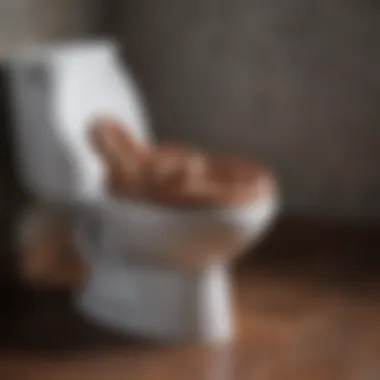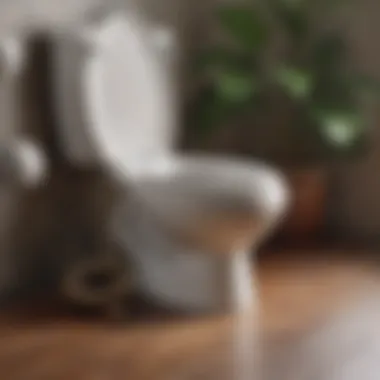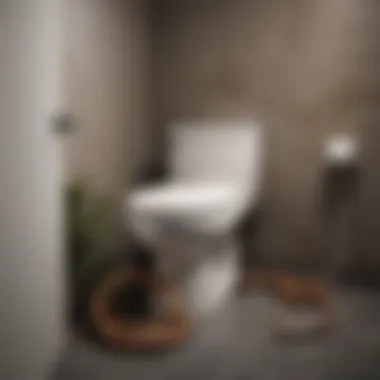Mastering the Toilet Snake: A Complete Guide


Intro
In every household, plumbing issues arise from time to time, particularly in the bathroom. One common problem is a clogged toilet. This situation not only disrupts daily routines, but also poses potential hygiene risks. To combat this, a toilet snake serves as a practical solution for homeowners looking for an effective way to clear blockages. Understanding the proper use of a toilet snake is essential for maintaining a functional bathroom.
This guide will break down the anatomy and functioning of a toilet snake, delve into the causes of clogs, and outline step-by-step instructions on how to use this tool effectively. We will also discuss critical safety measures, necessary maintenance, and when it is important to call a professional. By the end of this comprehensive examination, readers will feel confident in tackling toilet clogs themselves, which promotes informed home maintenance practices.
Understanding the Toilet Snake
Understanding the toilet snake is fundamental for homeowners facing plumbing issues. This tool provides a practical solution for addressing toilet clogs effectively, making it an essential part of home maintenance. Recognize that clogs can occur for various reasons, but having knowledge of the toilet snake can empower individuals to tackle these problems confidently. From its functions to its different types, each aspect offers insights into its overall utility. This section aims to clarify these elements and highlight the benefits of using a toilet snake for effective household management.
Definition and Purpose
A toilet snake, often referred to as a plumber's snake, is a long, flexible tool designed to clear clogs from toilets. Its primary goal is to reach obstructions deep within the toilet's plumbing system and remove them, restoring proper function. The ability to maneuver through narrow pipes sets the toilet snake apart from other plumbing tools, such as plungers. For any homeowner, understanding the definition and purpose of this tool is crucial in emergencies where quick resolution of a blockage is necessary.
Types of Toilet Snakes
When selecting a toilet snake, various types are available, each tailored for specific situations:
Manual Toilet Snake
The manual toilet snake is a simple yet effective tool. It consists of a long, coiled metal wire that is operated by hand. This type of snake is popular due to its cost-effectiveness and ease of use. Users can control the depth and pressure applied during the unclogging process.
The key characteristic of the manual toilet snake is its hand-crank mechanism, which allows users to manually navigate through pipes. This feature enables precision in handling different types of clogs. However, it does require physical effort, making it less ideal for severe blockages.
Advantages:
- Cost-effective
- Easy to use and control
Disadvantages:
- Requires manual labor
- May not be effective for very tough clogs
Electric Toilet Snake
In contrast to its manual counterpart, the electric toilet snake offers modern efficiency. This tool operates with a motor that drives the snake into the pipes automatically. Homeowners looking for a more powerful solution will find it advantageous.
The key characteristic of the electric toilet snake is its motorized function, which reduces the physical strain on the user. It can cut through tough blockages with less effort than a manual snake. However, proper handling is essential to avoid damage to plumbing systems.
Advantages:
- Effortless operation
- Effectively tackles stubborn clogs
Disadvantages:
- Higher cost
- Requires electrical outlet access
Flexible vs. Rigid Snakes


Flexibility in plumbing tools is vital. Flexible snakes can bend around corners in plumbing systems, while rigid snakes are better suited for straightforward paths.
The key characteristic of flexible snakes is their ability to adapt to various pipe shapes, making them essential in older homes with complex plumbing. They can maneuver through twists effectively, while rigid snakes offer strength for straight plumbing sections.
Advantages of Flexible Snakes:
- Ideal for complex plumbing
- Reduces the risk of pipe damage
Disadvantages of Flexible Snakes:
- May be challenging to control
Advantages of Rigid Snakes:
- Strong and capable of applying greater force
Disadvantages of Rigid Snakes:
- Limited maneuverability in complex pipe systems
Understanding the toilet snakes and their types helps homeowners choose the best one for their specific plumbing needs.
Common Causes of Clogs
Understanding the common causes of clogs is crucial when using a toilet snake effectively. Clogs can arise from various sources, and recognizing these helps in not only resolving current issues but also in preventing future ones. Maintenance of your plumbing system demands awareness of what can compromise its functionality. Knowledge of these causes empowers homeowners to adopt better practices.
Foreign Objects
Foreign objects account for a significant percentage of toilet clogs. Items such as toys, personal hygiene products, or even excessive amounts of hair can easily find their way into the toilet system. Unlike water and waste, these materials do not break down in the similar way. Oftentimes, children and pets unwittingly contribute to this problem by flushing items they shouldn't. To mitigate this issue, ensure that bathroom items are disposed of properly in trash bins. Regular checks to monitor what goes down the toilet can help avert emergencies.
Excessive Toilet Paper Use
Another prevalent cause of toilet clogs is the excessive use of toilet paper. Contrary to the assumption that all toilet paper will disintegrate easily, some thicker or layered types can create blockages. When combined with other waste, they can form a mass that the plumbing cannot handle. To prevent such problems, it is wise to be mindful of the amount of toilet paper being used. Educating everyone in the household about proper usage will go a long way in creating lasting solutions and reducing the frequency of clogs.
Tree Roots and Pipe Issues
Tree roots can be an insidious problem, contributing to clogs in an indirect manner. As trees mature, their roots often seek out moisture, penetrating pipes and causing blockages. This situation typically emerges in older plumbing systems where the integrity of the pipes may already be compromised. Identifying signs of this issue can be challenging, as they often manifest deeper in the system before causing noticeable clogs. Routine inspections and maintenance are ideal to ensure that tree roots are removed before they can create significant issues. If a clogs persists despite your efforts, consulting a professional may become necessary to evaluate the condition of the pipes.
Preparing to Use a Toilet Snake
Before employing a toilet snake, preparation is a critical step that can determine the efficacy and safety of the task. Understanding the significance of being well-prepared is vital. Proper preparation helps to avoid messy situations and pitfalls that can arise during the unclogging process. It ensures that you have all necessary tools at hand, provides a clearer understanding of what to expect, and promotes safety during operation. Moreover, a well-prepared approach enhances the likelihood of successfully addressing the clog on the first attempt, saving both time and effort.
Gather Necessary Tools
Having the right tools ready can make the unclogging process simpler and more effective. Here are the essential tools you should collect:
Safety Gloves


Safety gloves are an essential part of your preparation. These gloves protect your hands from potential contaminants and harsh materials that may be present in a clogged toilet. A key characteristic of safety gloves is their durability. They are designed to withstand contact with unsanitary substances while providing a good grip.
Using durable rubber gloves is a beneficial choice for this task as they offer waterproof protection. They allow for easier handling of the toilet snake and any debris that may come out during the unclogging process. However, it is important to ensure that the gloves fit well. Ill-fitting gloves can hinder movement and may cause accidental spills.
Bucket or Container
A bucket or container serves a practical role during the unclogging process. This tool catches any overflow or debris that might escape when you are working in the toilet. Its key characteristic is its capacity; choosing a container that is large enough helps manage waste effectively.
Selecting a sturdy bucket makes for a beneficial choice because it can withstand liquid and debris without leaking. A common disadvantage is the size; a large container can be cumbersome and hard to maneuver in tight spaces. However, the convenience it offers in keeping the area clean outweighs this issue during use.
Towels for Cleanup
Towels are another essential tool. They play a crucial role in cleanup after you complete the unclogging work. A key characteristic of towels suitable for this job is their absorbency; thick towels can effectively soak up any water or mess that results from the process.
Having disposable towels available is a popular choice since they can simply be thrown away after use. This feature reduces the risk of bacteria migration back into the environment. However, reusable towels may require washing, which can be less convenient if you want to avoid more work post-task.
Assessing the Situation
Once you have your tools gathered, the next step is assessing the situation. This involves examining the type of clog you are dealing with and determining whether a toilet snake is the appropriate solution. Look for signs of blockage, like gurgling sounds or incomplete flushes. A thorough assessment helps you to approach the clog with a clear plan and increases your chances of a successful resolution.
Step-by-Step Guide to Using a Toilet Snake
Using a toilet snake effectively is crucial for any homeowner facing plumbing issues. Understanding how to operate this tool can save time, money, and frustration. By mastering the step-by-step process, homeowners gain confidence in addressing toilet clogs. It also reduces reliance on professional plumbing services for routine issues, allowing for greater independence in home maintenance. In addition to mastering the technique, it is essential to recognize the importance of safety and proper handling of the snake to prevent any accidents.
Insert the Snake into the Toilet
The first step in unclogging a toilet involves carefully inserting the snake into the bowl. This process requires precision to avoid damaging the toilet. Hold the snake with one hand while supporting it with the other. Ensure you are at an angle that allows for smooth entry. Gently guide the head of the snake into the toilet drain. Avoid using excessive force at this stage. Instead, allow the snake to navigate naturally into the drain’s opening.
Navigating the Trap
Once the snake is in, the next part involves maneuvering it through the toilet's trap. This section can be challenging due to its curvature. Move the snake with caution; twist and push lightly, allowing the flexible end to follow the pipe’s path. If you encounter resistance, do not force it. Instead, make slight adjustments to direction while slowly feeding more of the snake into the drain. This approach helps you identify the clog's location without damaging the pipes.
Cranking the Snake
Now that the snake is in position, it’s time to begin cranking it. This action is critical in breaking through any material causing the blockage. Use the handle to turn the snake clockwise. This motion helps the snake’s auger style head to grasp and shred through the clog. Maintain consistent pressure but do not crank too hard; gentle, steady movements are key. If you feel the snake break through the clog, you may notice some resistance decrease; this is a sign of progress.
Removing the Clog
Once the clog has been effectively broken down, it's necessary to withdraw the snake. Slowly pull the snake out while continuing to crank it. Pay attention to the material that may come through with the snake. This can be an indicator of the clog's makeup. As the device comes out, clean off any debris before setting it aside. It’s essential to ensure that the area surrounding the toilet is still clear of any mess.
Testing the Flush
After clearing the clog, the final step in the process is testing the flush. This action will help determine if the problem has been resolved. Carefully observe how the water flows; if it exits fully and without obstruction, the task was successful. In case the clog remains, it might require additional attempts to use the snake or a different method might be necessary. Never skip this step as it ensures the functionality of the toilet is restored, allowing for normal use once again.
Final Thought: Mastering the use of a toilet snake empowers homeowners, providing them with a valuable skill for maintaining plumbing efficiency.
Safety Precautions


Safety precautions are essential when using a toilet snake. The process of unclogging a toilet can often lead to messy situations and potential health hazards. Therefore, being aware of the necessary safety measures helps protect both you and your bathroom. It is important to prioritize your health and welfare while performing any home maintenance task, especially one that involves plumbing.
Protective Gear
Before reaching for your toilet snake, it's critical to equip yourself with proper protective gear. This gear can help shield you from potential contaminants and minimize injury risks.
- Safety Gloves: Wearing durable, waterproof gloves is crucial to prevent direct contact with any waste material or harmful bacteria. Look for gloves made of rubber or latex that offer a good grip. This will enhance control when maneuvering the snake.
- Goggles: Safety goggles are beneficial to protect your eyes from any splashes or debris when you insert the snake into the toilet. Even minimal exposure to wastewater can lead to infections or irritations.
- Mask: Consider wearing a mask as a precaution against inhaling any unpleasant odors. This is especially relevant if the clog produces a strong smell or if you are in a closed space.
Using protective gear reduces the risk of side effects linked to plumbing clogs. Appropriate investment in gear is, therefore, advisable for anyone who plans to dive into DIY plumbing tasks.
Managing Spills
While dealing with toilets is inherently prone to spills, managing them effectively is essential for maintaining a clean and safe environment. Here are strategies to minimize the impact of any spills while you work with a toilet snake:
- Have Towels Ready: Keep a stack of old towels or rags close by. If there is a spill, immediate cleanup can prevent slips and minimize the mess.
- Use a Bucket: Place a bucket under the toilet to catch any overflow. This can prevent larger areas from becoming soiled, making post-usage cleanup easier.
- Seal Off the Area: If possible, restrict access to the bathroom during the unclogging process. This will limit exposure to any spills, especially for children or pets.
- Disinfect After Use: After successfully using the toilet snake, clean any areas that were exposed to waste. This includes surfaces and tools that might become contaminated during the process. Using a disinfectant is advisable for health safety.
Post-Use Maintenance of the Toilet Snake
Post-use maintenance is crucial for any tool, and a toilet snake is no exception. Proper care after using it not only ensures its longevity but also promotes hygiene and safe storage. Neglecting maintenance can lead to corrosion, build-up of residue and bacteria, which can compromise the functionality of the snake during future use. Therefore, understanding how to effectively clean and store the toilet snake is essential for every homeowner.
Cleaning the Snake
Cleaning the toilet snake after each use is vital. Residue from the clog can cling to the device, and if left untreated, it could become a breeding ground for germs. Start by wearing protective gloves to avoid direct contact with any unpleasant materials. Use warm, soapy water to scrub the snake thoroughly. A stiff brush can help remove stubborn debris and build-up. Rinse it well to ensure no soap remains.
After rinsing, it is advisable to disinfect the snake with a mixture of water and vinegar or a diluted bleach solution. This step eliminates bacteria and prevents the growth of mold. Allow the snake to dry completely before storing it. By keeping your toilet snake clean, you ensure its readiness for the next use and maintain a hygienic environment.
Storing the Snake Properly
Proper storage of the toilet snake is equally important. After cleaning, choose a designated area that is dry and easy to access. Avoid keeping the snake in damp areas as this can lead to rust or damage. Utilizing a storage container can help protect the snake from dust and dirt, ensuring it remains in good condition.
Position the snake in a way that does not bend or crimp the coils, as this could affect its function. Some prefer to hang the snake on a wall-mounted hook for ease of access. Labeling the storage area can also be advantageous, especially if you own multiple maintenance tools.
Remember, a well-maintained toilet snake not only works better but also lasts longer, providing value for your investment.
When to Call a Professional
In certain situations, despite your best efforts, using a toilet snake may not yield the desired results. Understanding when it is prudent to call in a professional plumber can save you time and potential further damage. Engaging with experienced professionals provides both relief and certainty as they navigate complex plumbing challenges that may exceed the capacity of a standard toilet snake. Here are crucial moments when seeking professional help should be considered:
Persistent Clogs
When multiple attempts to unclog the toilet have failed, a persistent blockage indicates a more profound issue within your plumbing system. If the snake does not adequately clear the congestion after several tries, it may signal an obstruction deeper in the plumbing or a more complex issue, such as:
- Severe Buildup: Accumulations of materials over time could have formed a large mass that requires specialized equipment.
- Pipe Misalignment: Shifts in pipe structure could prevent effective snake operation.
In some instances, persistent clogs can result from tree roots infiltrating pipes or other serious plumbing defects. Ignoring these signs may lead to more extensive damage and costly repairs. A professional will conduct a thorough assessment, potentially using camera inspections to accurately diagnose the problem.
Visible Damage to Pipes
Any visible damage to pipes is a critical indicator for professional intervention. Signs of damage may include:
- Leaks: Water pooling around the base of the toilet or signs of dampness on nearby walls.
- Cracks or Rust: Discoloration or apparent fractures on exposed piping indicating a breach.
- Unusual Sounds: Gurgling noises from your plumbing, signaling irregularities in water flow.
Damaged pipes can cause significant issues and require immediate attention. Attempting to resolve these issues without proper knowledge and tools can lead to exacerbation of the problem and safety hazards. A qualified plumber possesses the training and expertise necessary to evaluate the full extent of damage and implement the appropriate solutions.















